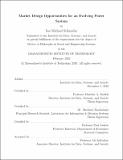| dc.contributor.advisor | Munther A. Dahleh and Mardavij Roozbehani. | en_US |
| dc.contributor.author | Schneider, Ian Michael. | en_US |
| dc.contributor.other | Massachusetts Institute of Technology. Institute for Data, Systems, and Society. | en_US |
| dc.date.accessioned | 2020-11-24T17:32:28Z | |
| dc.date.available | 2020-11-24T17:32:28Z | |
| dc.date.copyright | 2020 | en_US |
| dc.date.issued | 2020 | en_US |
| dc.identifier.uri | https://hdl.handle.net/1721.1/128639 | |
| dc.description | Thesis: Ph. D. in Social and Engineering Systems, Massachusetts Institute of Technology, School of Engineering, Institute for Data, Systems, and Society, February, 2020 | en_US |
| dc.description | Cataloged from student-submitted PDF version of thesis. | en_US |
| dc.description | Includes bibliographical references (pages 117-126). | en_US |
| dc.description.abstract | The rapid growth of renewable energy is transforming the electric power sector. Wind and solar energy are non-dispatchable: their energy output is uncertain and variable from hour-to- hour. New challenges arise in electricity markets with a large share of uncertain and variable renewable energy. We investigate some of these challenges and identify economic opportunities and policy changes to mitigate them. We study electricity markets by focusing on the preferences and strategic behavior of three different groups: producers, consumers, and load-serving entities. First, we develop a game-theoretic model to investigate energy producer strategy in electricity markets with high levels of uncertain renewable energy. We show that increased geographic dispersion of renewable generators can reduce market power and increase social welfare. We also demonstrate that high-quality public forecasting of energy production can increase welfare. Second, we model and explain the effects of retail electricity competition on producer market power and forward contracting. We show that increased retail competition could decrease forward contracting and increase electricity prices; this is a downside to the general trend of increased access to retail electricity competition. Finally, we propose new methods for improving demand response programs. A demand response program operator commonly sets customer baseline thresholds to determine compensation for individual customers. The optimal way to do this remains an open question. We create a new model that casts the demand response program as a sequential decision problem; this formulation highlights the importance of learning about individual customers over time. We develop associated algorithms using tools from online learning, and we show that they outperform the current state of practice. | en_US |
| dc.description.statementofresponsibility | by Ian Michael Schneider. | en_US |
| dc.format.extent | 126 pages | en_US |
| dc.language.iso | eng | en_US |
| dc.publisher | Massachusetts Institute of Technology | en_US |
| dc.rights | MIT theses may be protected by copyright. Please reuse MIT thesis content according to the MIT Libraries Permissions Policy, which is available through the URL provided. | en_US |
| dc.rights.uri | http://dspace.mit.edu/handle/1721.1/7582 | en_US |
| dc.subject | Institute for Data, Systems, and Society. | en_US |
| dc.title | Market design opportunities for an evolving power system | en_US |
| dc.type | Thesis | en_US |
| dc.description.degree | Ph. D. in Social and Engineering Systems | en_US |
| dc.contributor.department | Massachusetts Institute of Technology. Institute for Data, Systems, and Society | en_US |
| dc.contributor.department | Massachusetts Institute of Technology. Engineering Systems Division | |
| dc.identifier.oclc | 1223507045 | en_US |
| dc.description.collection | Ph.D.inSocialandEngineeringSystems Massachusetts Institute of Technology, School of Engineering, Institute for Data, Systems, and Society | en_US |
| dspace.imported | 2020-11-24T17:32:27Z | en_US |
| mit.thesis.degree | Doctoral | en_US |
| mit.thesis.department | ESD | en_US |
| mit.thesis.department | IDSS | en_US |
